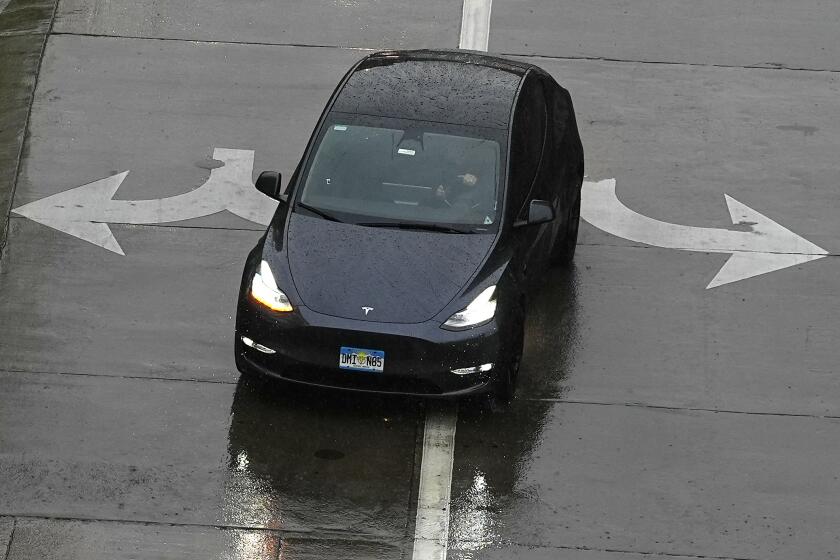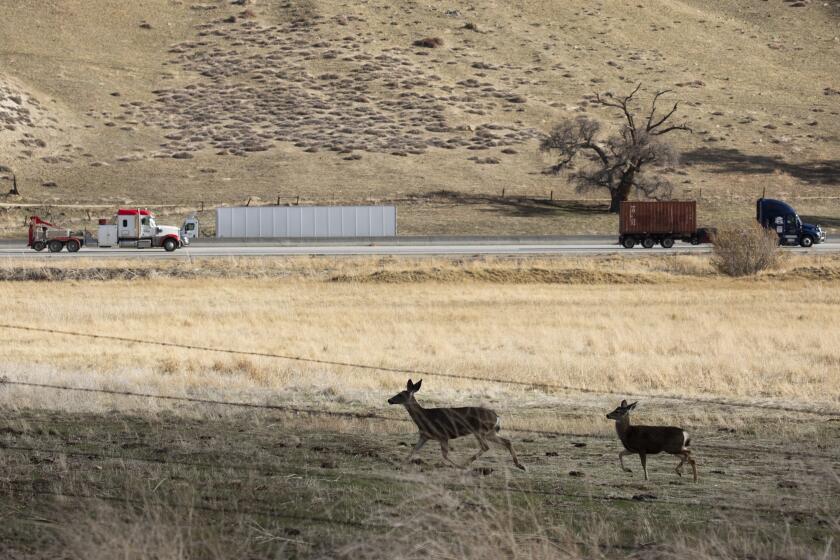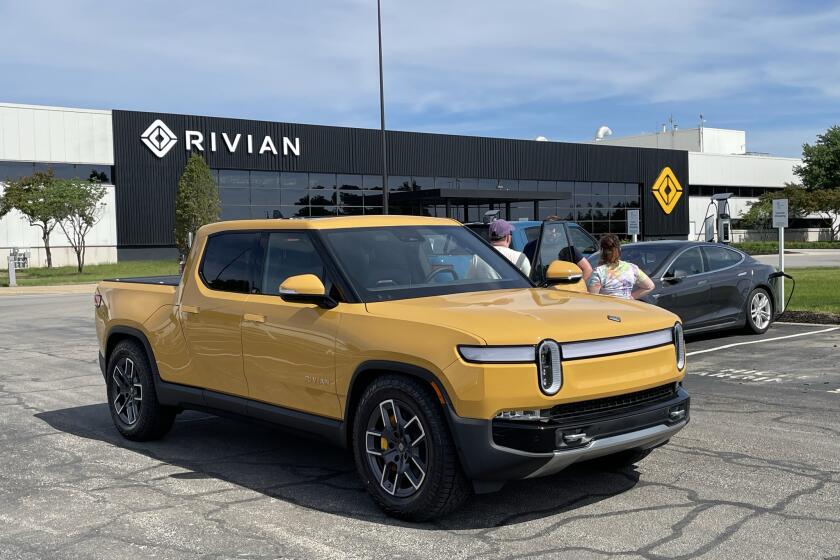Volkswagen’s New Jetta Drops Handling Off at Corner and Heads Up-Market
Beware, all ye who drive light of heart and leaden of loafer. Do not be seduced by the cut of the 1999 Volkswagen Jetta GLX. Nor besotted by the visuals and mechanicals: its 16-inch alloy wheels, a 174-horsepower V-6 mated to a five-speed manual, a walnut-knobbed shifter and similar suggestions of serious driving on roads and tracks.
Buy into such nuances, and you could learn the softness of the GLX the hard way. Which will have spit drying on your teeth and tires yelping at partial meltdown as your briskly driven Jetta lightens and lifts perilously on the high side and informs you that forward movement by sideways passage is imminent.
That’s how we slud through Turn 8--a quick yet uncomplicated right-hander with 100-mph entrance speeds the norm for sportier compacts--while romping with the new Jetta at Willow Springs International Raceway.
Being occasionally humble--although thoroughly married--I blamed myself for this embarrassing show of screak and smoke. Then, same corner, same speed, same turn-in point, but with milder steering input. The Jetta again made like a sponge-rubber ball being nosed around the kitchen by Fido.
One more time, but at a lesser speed on a tighter left-hander. The Jetta did not come unglued; far from it. But lean, beginning understeer, and a definite loss of information from wheels and chassis continued to make for some tummy-sloshing moments requiring quick correctional twitches.
Such handling is a sorry stain on Volkswagen’s sterling reputation for building stiff, nimble, holy terriers with precise and predictable responses. Such as several generations of the gymnastic Golf GTI.
“Jetta is a more compliant ride,” concedes Volkswagen spokesman Tony Fouladpour.
“Ride and handling have been dialed in to reinforce the fact that the car has moved a little further upscale. It is a little bit different, not as stiff as it used to be . . . and there have been [factory] discussions about stiffening the Jetta’s spring rate by 10%,” he added.
It is important to note that Jetta’s jelly roll is not an issue that will have Ralph Nader calling for a fresh lance and dusting off his Corvair playbook. But it certainly narrows the versatility of an otherwise fine vehicle, reducing the Jetta to a comfortable, high-quality compact for inter- and intracity travel. But with the functions of fun and sportiness strictly a matter of perceptions past.
This fourth-generation Jetta--essentially a four-door Golf with a trunk, and sharing a platform with the Golf, the New Beetle and the incoming Audi TT two-seater--comes with choice of three power sources. A 2.0-liter, 115-horsepower four-banger is the standard engine, followed by the 2.8-liter V-6, to be followed next year by Volkswagen’s splendid 1.9-liter, turbocharged diesel. Blessing of the last is performance on a par with the 2.0-liter, and with a highway fuel consumption of almost 50 miles per gallon.
Jetta is available with a five-speed manual or a four-speed automatic transmission, and trim levels are GL, GLS and GLX, the usual stretch from lightly endowed to expansively loaded. The 2.8-liter VR6 engine of proven ginger is standard in the GLX and, for the first time, an option for GLS buyers.
The car is a looker, with a bobbed trunk (do not despair, it offers 13 cubic feet that will swallow the gear of four fishermen and most of their bass boat), an arched top and a short, sloping front. It’s a Passat with puppy fat. There’s also a soupcon of Beetle in the shape and a full helping of Audi, both paying homage to a definite shape of the ‘90s that has become a German silhouette as recognizable as the Hindenburg.
Only one visual sore thumb: a grille badge enlarged to the size of a dinner plate.
Jetta is shorter, wider and half an inch higher than its immediate predecessor. More important in the auto industry’s never-ending search for a little more stability, a skosh more control, Jetta’s wheelbase has been stretched by 1.5 inches and its track widened by almost 2 inches.
Volkswagen crams the Jetta with more than enough trinkets and conveniences to pacify those who might get tummy ache at the thought of paying between $17,000 and $24,000 for a compact car. In tighter focus, the Jetta’s high bauble count is probably why the least expensive GL--with side air bags, anti-lock brakes and central locking--is $17,000. Or about the price of a similarly equipped four-door at the top of the Honda Civic food chain.
However, the biggest ball in this juggling act of content versus price has to do with Volkswagen being the only overseas manufacturer building a compact with a V-6. And along with that torquey big engine in the GLX, you get standard leather upholstery, heated seats, power sunroof, automatic air, halogen headlights that will reach to the next town and automatic wipers that make like squeegees the moment God spits on your windshield. Plus a seat belt and third headrest for baby or your teddy bear in the very roomy back seat.
From the faux-suede surface of the dashboard to instruments back-lit in lapis blue with glowing red needles, it is all contemporary, top-quality stuff. The sense from inside is of a $30,000 motorcar. Grab handles will not grab your fingertips; the carpeted trunk has hydraulic hinges that will not groove and harpoon your Samsonite; and there are assist handles inside the trunk lid so you don’t leave jammy fingerprints on the paint.
The Jetta is a nice piece of work deserving of a higher station. But when attempting to move anything smoothly and softly up-market, best to make sure its sneakers fit and the laces are tied.
Times automotive writer Paul Dean can be reached via e-mail at paul.dean@latimes.com.
(BEGIN TEXT OF INFOBOX / INFOGRAPHIC)
1999 Volkswagen Jetta GLX
Cost
* Base, $23,500. Includes automatic climate control, leather seats, wood trim, front power seats, rear sunshade, anti-lock brakes, power sunroof, halogen fog lamps, rain sensor, trip computer, self-dimming rearview mirror, side air bags, alarm, eight-speaker sound system, heated seats, central locking, power windows and mirrors, alloy wheels and five-speed manual transmission.
* As tested, $24,080. Adds 16-inch wheels, sport seats and destination charges.
Engine
* 2.8-liter V-6, developing 174 horsepower and 122 pounds-foot of torque.
Type
* Front-engine, front-wheel-drive, four-passenger compact sedan.
Performance
* 0-60 mph, as tested, in 7.9 seconds.
* Top speed: 135 mph (estimated).
* Fuel consumption, city and highway, with five-speed manual: 19 and 28 miles per gallon (Environmental Protection Agency estimates).
Curb Weight
* 3,019 pounds.
(BEGIN TEXT OF INFOBOX / INFOGRAPHIC)
****
The Good: Styling, mechanicals and quality moving noticeably closer to Audi and other European upper-class cars. Only imported compact offering V-6 engine; only compact with side air bags. Enough rear seat room for adults, enough trunk space for their luggage. Car actually feels much more expensive than its sticker indicates.
The Bad: Despite sporty appearance and reputation, handling gets confused and mushy, particularly during directional transitions. Pricey for a compact, because it is equipped like no other compact.
The Ugly: Grille badge that’s same height as grille.



